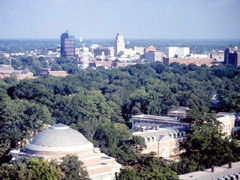Durham, North Carolina: The Flower of the Carolinas and Home to Basketball

Durham, North Carolina has a history well embedded from the early days of the tobacco industry to today’s extension of the famous Research Triangle Park. Although a small town initially, Durham played pivotal roles in many of the battles throughout the beginning of the nation’s development. It has been called the Flower of the Carolinas due to the incredible beauty and charm of the area. Duke University is a focal point of the town, with the Blue Devils athletic assoiation and an incredible array of sports. Basketball is one of the favorite sports in Durham and the basketball scoreboards are the focus of the game.
The Native American tribes of the area were the original inhabitants and were also key to the development of The Great Indian Trading Path. This roadway became an established method for transportation of good and services in the early settlement days. The mid 1700’s brought a number of European settlers to the Durham area which was prized for its agriculture. The growth of larger plantations, along with the African slaves that became the labor in the area, encouraged the town to blossom.
While there was a small community of Black Americans that were free, the majority was slaves and this philosophy embroiled the Durham area into the Civil War with an unusual twist. Durham became the center for both Confederate and Union troops, who favored the particular tobacco of the area. The addition of the railroad also changed the face of trade in Durham. The latter part of the Civil War wreaked havoc, as the end brought about Union troop looting of the town. This forever affected the attitudes of the residents in a negative way.
Post war time offered a better economy as the people focused on the rebuilding of their area. Tobacco became the mainstay crop and factories were built, which brought a better life for everyone. By the 1900’s, the explosion of success also brought additional industries which included investment in electric power and textiles. The social influences also changed as the Black community population increased. The addition of Black schools, churches and colleges influenced the look and feel of the city, but it was the music and arts of the Black community that had the most effect not only on Durham but the rest of the country as well.
The local college was eventually renamed to the now well known Duke University, however by the 1930’s the factories that produced the textiles that kept the engine of Durham running, soon began to close. The Civil Rights Movement played front and center and, as a southern city, the many sit ins were not dealt with well. As the people of Durham learned, it takes time to make any change, but change was on their horizon.
In an effort to maintain the economy, the people of Durham partnered with the growing area now called Research Triangle Park. By this time, the area was rich in jazz music and the town had been revitalized to display the many museums, arts festivals and their passion for sports. Duke University has become one of the top sports schools in the nation, including baseball, basketball, football, field hockey, swimming, tennis, volleyball, track & field, wrestling, fencing and lacross. The people of the area love attending every kind of game, but basketball seems to be tops. Their local team results projected proudly on the basketball scoreboards, leading them to victory. Durham has become the home of many well known jazz and blues musicians of today. The people of the area take pride in the beauty of nature and their town. Their incredible passion for their sports teams is blended with the intense talent of the music. It isn’t uncommon to see dancing and music when the scoreboards light up with the winning victory for their teams.


